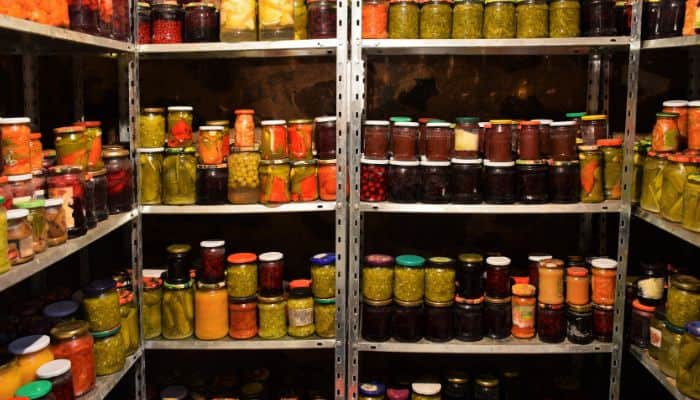Table of Contents
Why Stockpile Food and Water for Emergencies?
In times of crisis or natural disasters, access to clean water and enough food can become limited or even nonexistent.
Emergencies come in all shapes and sizes, from power outages and severe weather conditions, to pandemics, economic downturns and all-out SHTF situations like a nuclear attack.
With so many unpredictable factors at play, you need to be prepared as much as possible. Stockpiling food and water is a practical and proactive way to prepare for any kind of emergency, big or small.
Where to keep your Stockpile?
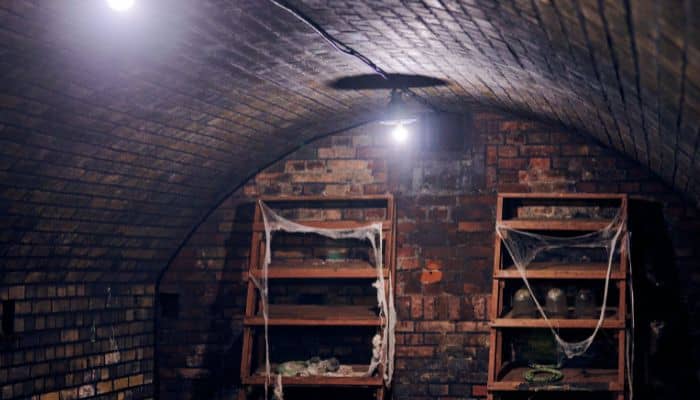
So you’ve decided you want to build a stockpile for when SHTF, good choice but you need to remember its key to choose the right storage area.
This will affect how easily you can access everything and how long it stays preserved.
Shelters
If you have your own shelter, like a basement, storm cellar or ideally a full-blown fallout shelter or bunker it would be an ideal spot to store your emergency stockpile.
Shelters offer protection from external threats like severe weather conditions, vandalism, looting and radiation.
If you have a proper ventilation system, they can even shield your supplies from extreme temperatures, sunlight and humidity, which can affect the shelf-life of your food and minimize risk of bacteria getting into your drinking water.
You should organize everything and make use of shelving units and stack-able containers. Make sure everything is sealed and protected from moisture or pest infiltration.
Regularly check for any signs of damage or deterioration and address them promptly.
Indoors
Don’t have a shelter or bunker? No worries, not everyone will be doing this (or have the means) to prepare for the absolute worst and there are still safe areas you can use inside your house or apartment.
You can safely store your supplies in pantries, cupboards, closets or spare rooms. Use storage bins and think vertically by using can racks and hanging shelves.
Avoid areas of your house that are prone to temperature extremes, like your attic.
Keep your stockpile of food and water in a discreet area to avoid some looter breaking in and stealing your supplies.
Outdoors
When indoor space is limited or simply not an option, you can always use outdoor areas, like sheds, garages or storage units located on your property or close by.
Consider these 3 things when choosing a location:
- Security: Use strong locks, if possible install surveillance cameras or motion sensor lights to deter looters.
- Climate Control: Make sure your using insulation, ventilation or dehumidifiers.
- Protection: Protect against natural elements like rain, snow and direct sunlight. Keep everything in sealed containers and protected from potential water damage.
How long to Stockpile for?
Before you order 1000 cans of Spam and bottles of water, let’s talk about some factors that might affect your emergency stash.
Storage space, the type of emergencies you’re prepping for and how much money you can dedicate to this, all matter.
Money
Long-term prepping can be expensive, so unless you’re filthy rich, it’s important to know your limits and put some aside for emergencies.
Don’t only think of the short-term just to save money. Try to balance both immediate needs and future sustainability.
You can save money by buying in bulk, looking for deals and discounts and gradually building your stockpile over time.
Prioritize the essentials, water, non-perishable food and first aid kits.
These are the foundation of any stockpile, even with a limited budget.
Risk Assessment
To know how much food and water you’ll need to prep for an emergency, you need to think about what kind of SHTF situations you’ll find yourself in.
Consider the worst-case scenario when assessing the duration of time your stockpile needs to last.
It is generally recommended to have two weeks of supplies at a minimum. However, depending on your specific circumstances and the nature of potential emergencies, you may choose to extend your stockpile to a month or even longer.
Storage Space
When deciding how long you might need to hold out for, you should also think about how much space you have to store everything.
You can fit more if you use your space well.
If you don’t have a lot of space, try using shelves or containers that can be stacked on top of each other. Make use of areas that are not being used, like the space under your bed, behind doors or on top of cabinets.
Use vacuum-sealed bags to compress your bagged food so it takes up less space.
What kinds of Food and how much?
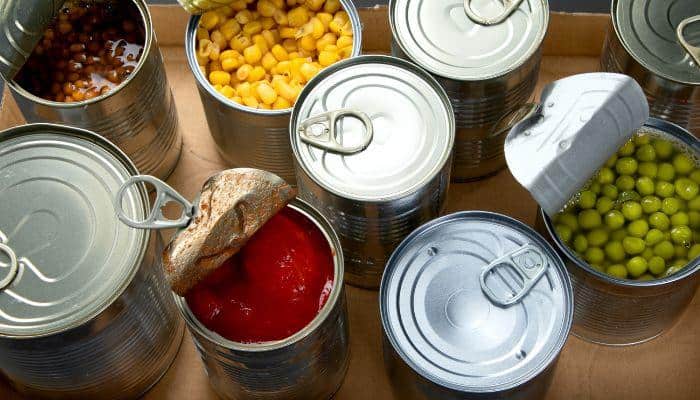
How much Food?
The amount of food you should stockpile depends on several factors, including the size of your household, individual dietary needs and the emergencies you are preparing for.
Your goal is to have enough food to sustain everyone for the duration of the situation and having a little extra as a buffer.
Prepping now can save you a world of trouble when and if the grocery stores start having shortages, cities fall to mass riots or worldwide famines begin plaguing crops like we’ve seen throughout history and most recently with the COVID pandemic.
As mentioned earlier, we suggest having at minimum two weeks of food per person. While we absolutely recommend having several years worth, it is not always realistic.
Food Containers
You need to choose the right containers for storing your emergency food. Opt for sturdy, airtight containers that can protect your food from moisture, pests, spoilage, airborne toxins and bacteria.
These are the best types of food storage containers you can use
- Self-Canned Food (If done correctly can ensure a decades long-shelf life)
- Food-Grade Plastic Buckets with Secure Lids
- Mylar Bags with Oxygen Absorbers
- Vacuum-Sealed Bags
- Air-Tight Mason Jars

Label all of your containers with the contents and expiration dates to make them easy to inventory and organize.
Types of Food
When shopping for your emergency stockpile, make sure you have a balanced assortment that gives adequate nutrition and can be stored for long periods of time.
Focus on non-perishable food items that require minimal or no cooking, as well as foods with long shelf lives.
To determine the total number of calories necessary for your stockpile, simply calculate the daily caloric requirements of each person and multiply it by the chosen time-frame you’re prepping for.
Here is our recommended list of food to consider:
Canned Goods
Canned foods are the gold standard of food prepping and always a good idea to keep in case of an emergency.
They are cooked before being put in the can and don’t go bad quickly. You can get different types of canned fruits, vegetables, meats and fish.
Pick cans with less sodium. Salt, by itself, is easy to store and lasts an extremely long time. Be sure to leave a couple can openers nearby for obvious reasons, although in a pinch, a knife would be fine.
Dried Foods
Dried foods are lightweight, space-efficient and have long shelf lives.
Dried fruits, nuts, granola bars, beans, rice, pasta and meat like jerky are perfect choices for this because they can be consumed as is or re-hydrated with water.

MRE’s
MRE’s (Meals Ready to Eat) are designed specifically for emergencies and require no additional preparation.
They come in various flavors and provide a complete meal in a single package.
Keep in mind, you will need to rotate these more often than some of the others on this list to maintain freshness.
Shelf-Stable Milk and Beverages
Include shelf-stable milk, powdered milk or boxed plant-based milk options in your stockpile.
Staple Foods and Condiments
Don’t forget to include essential staples such as flour, sugar, salt, cooking oil and condiments like ketchup, mustard and mayonnaise.
You will at some point, get sick and tired of eating the same thing over and over and having these gives a bit of versatility in your cooking options and in the flavor department.
Baby Food and Formula
If you have infants or very young children, then it’s important not to forget baby food, formula and other necessary items like diapers and wipes. Remember, babies have incredibly specific dietary needs.
Special Dietary Needs

Know what restrictions people in your household have.
If anyone has allergies or requires specific diets then you better have suitable options available to them, especially for life-threatening conditions that require certain diets.
Ensure a balance of nutrients, including carbohydrates, proteins, fats, vitamins and minerals, to meet basic nutritional needs.
Buy vitamins and other supplements to help offset the lack of any nutrients you may not be getting.
Recipes
Finally, make sure you have some recipes written down or get yourself a survival cookbook.
Just because you’re in this situation doesn’t mean you have to suffer the same bland tastes day-in and day-out. Spice things up with some homemade food using the ingredients you’ve already stockpiled.
Just remember to calculate what you’ll need in advance to make sure you don’t over or under-proportion your reserves and put yourself in a worse situation.
How much Water is needed and how to store it?
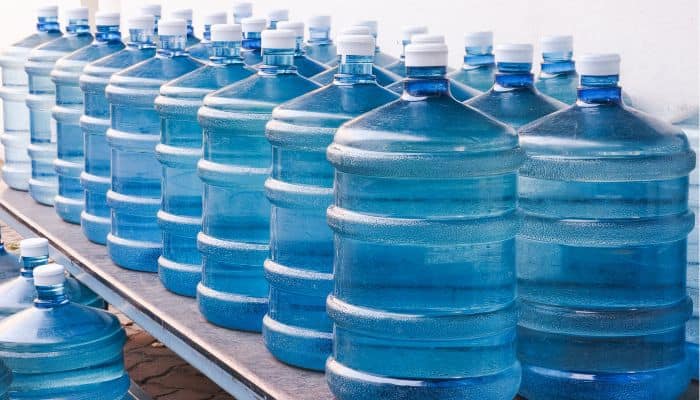
Water is a top priority and hands down more vital to survival than food. So make sure you stockpile enough H20 to keep you hydrated and clean.
But how much is enough? Well, let’s think about it.
How many people are in your household? What’s the temperature like? Do you have any pets or sick people to care for?
These are all important factors to consider when deciding how much water to hoard.
Water Containers
Storing your water safely and preserving its quality should be your top priority.
Go with FDA approved, food-grade BPA-free plastic containers, such as sturdy water jugs or water drum barrels. Be sure that the containers have secure lids to prevent contamination and spillage.
Consider using containers that are opaque or made of UV-resistant materials to minimize exposure to sunlight, as this will negatively affect the quality of the water over time.
The general rule of thumb is to always store your water in a dark place, away from direct sunlight, no matter which container you go with.
Remember to label containers for their purpose (drinking and sanitation) with the storage and expiration dates.
How much Water?
The general guideline for water stockpiling is to have at least one gallon (3.8 liters) of water per person, per day.
This includes both drinking water and water for sanitation purposes. However, individual water needs change depending on things like age, the climate you’re surviving in, physical activity, and health conditions. You can use this hydration calculator to figure out your specific daily needs.
Let’s do the math.
All you need to do is multiply the daily water consumption based off the number of people in your house, by how long you want your stockpile to last.
For instance, a family of four gearing up for a two-week emergency would require a minimum of 56 gallons of water (4 people x 1 gallon per day average x 14 days).
It’s also worth mentioning that you need to factor sanitation and hygiene in as well.
The water calculated is for drinking and sanitation purposes together and between the two, the CDC recommended 1 gallon a day, really isn’t much.
The bottom line is you can never have too much water.
Just keep in mind, water should be swapped out every 6 months (except in extreme circumstances or when it can be tested and re-purified if necessary) and should be stored between 50°F –70°F.
Water Purification
Being able to purify water and make use of alternative water sources (if you have to) can save your life should your stockpile run out.
It’s imperative to have purification methods available. There are several ways to purify water, including:
Water Purification Tablets
Water purification tablets or drops containing chlorine, iodine or other disinfecting agents can be used to treat water.
Follow the instructions provided with the tablets or drops for proper dosage and contact time to guarantee a thorough purification.

Water Filters and Sterilization
Water filtration systems with activated carbon filters or ceramic filters can remove impurities and contaminants from water.
Look for filters that are specifically designed for emergency situations and capable of removing bacteria, protozoa and viruses.
Some advanced water filters combine filtration with ultraviolet (UV) sterilization to eliminate bacteria, viruses and other harmful microorganisms. These filters are highly effective and provide an additional layer of protection.
Boiling
Boiling water is a semi-effective way to kill most microorganisms.
Bring water to a rolling boil for at least one minute (or 3 minutes at higher altitudes) to make it is safer to drink. Boiling water is a great fallback option but certainly not our first choice.
Maintaining Your Stockpile
So you’ve got your emergency stash all squared away, which is great but you’re not done yet!
You still have to take full inventory and write it down somewhere. Keep it updated and maintained if you want to be ready at all times for any SHTF scenario.
Here is exactly what you need to be doing on (at least) an annual basis:
Regular Inspection
Periodically inspect your stockpile to check for any signs of damage, spoilage or expiration. Check to see if all the containers are intact, properly sealed and free from any signs of pests or moisture.
Trash and replace any items that have passed their expiration dates or show signs of deterioration.
The last thing you want is a stockpile full of garbage and outdated supplies.
Rotation
To maintain freshness and quality, practice a rotation system for your food and water supplies.
Use the “first-in, first-out” principle, consuming and replacing the oldest items with new ones. This guarantees that your stockpile remains up-to-date and that you always have a fresh supply of food and water.
Assess Evolving Needs
As time passes, your emergency needs may change. Review and reassess your stockpile periodically to align it with your current circumstances. Adjust the size of your stockpile based on evolving risks, changes in family size, budget or specific health conditions.
Adapting your Stockpile for Different Emergencies

Different emergency situations present different challenges. Recognizing this is instrumental when building a stockpile that caters to per-situation specific needs.
Natural disasters
Natural disasters, such as hurricanes, earthquakes or floods, usually result in power outages and limited access to grocery stores and other resources.
When preparing for natural disasters, focus on non-perishable food items, portable cooking options and ample water storage. Also prep other essentials like flashlights, batteries, first aid kits and blankets.
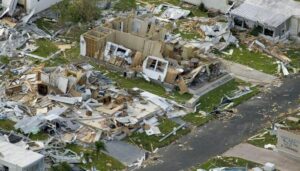
SHTF (Sh*t Hits The Fan)
In extreme situations where societal systems collapse, stockpiling becomes critical for long-term survival.
In this case, focus on a more extensive and diverse stockpile, including seeds for growing food, tools for self-sufficiency and the means to defend yourself, family and supplies. Building a community or joining a survival group can also provide added support.

Wartime
During times of war or civil unrest, access to food and water may become limited because of disrupted supply chains. In addition to stockpiling food and water, it is advisable to keep a low profile, maintain situational awareness and have contingency plans in place.
Consider the potential length of the conflict and adjust your stockpile as needed.
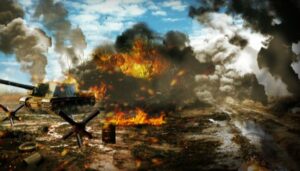
Final Thoughts
In an Ideal world, we would have the money, time and resources needed to build multiple stockpiles for different situations but this is just simply not the reality most of us live in.
If you followed our guide, you should be more than prepared to begin building the perfect emergency stockpile for food and water and well on your way to the next level of preparedness.
You might also like:
How to Survive a Nuclear Attack: 10 Important Things to Consider


